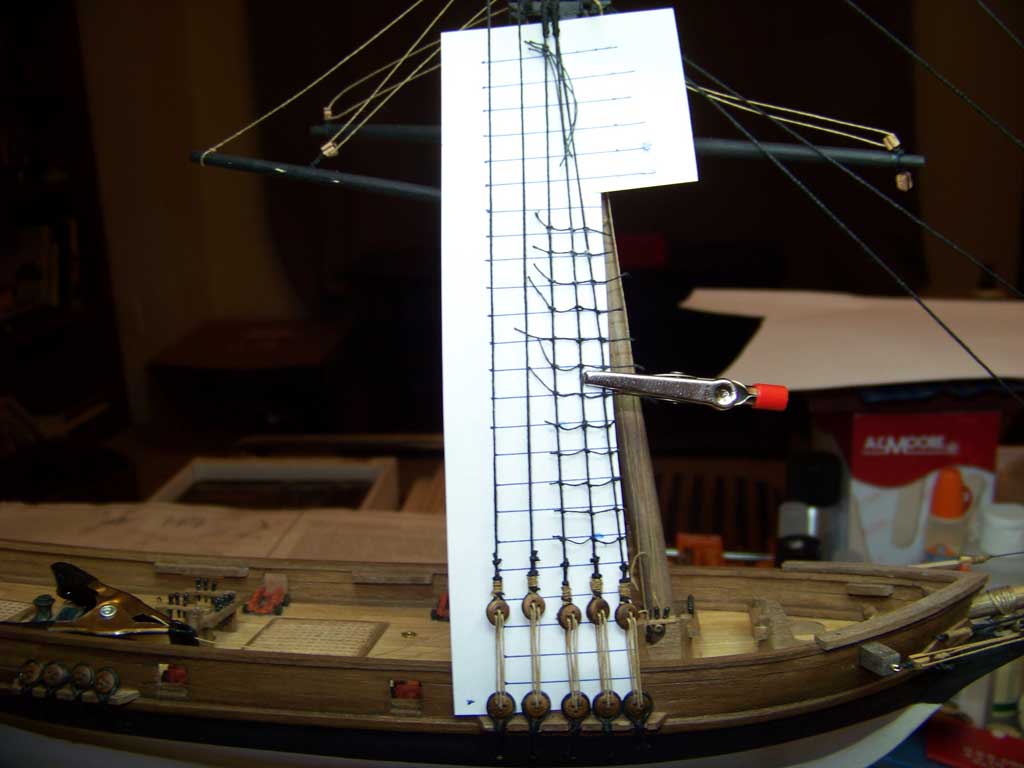The end is in sight.
Posted By Russ Emerson on February 23, 2010 at 4:44 pm
This being my first effort at shipwrightry, I think I’ve been wasting quite a bit of raw material. More rigging line ends up being trimmed off than on the model. As a result, I sort of ran out of one particular type….
You can see in the pictures that there are two colors of rigging, black and “natural.” Black line represents rope that would have been slathered in tar, which stiffened them and helped preserve them against wear, tear, and the effects of being exposed to the elements. This was typically done with ropes and cables that were meant to stand in place full time, such ropes earned the term “standing rigging,” and included such items as the shrouds and stays.
Ropes that were meant to be frequently worked by the crew needed to be more flexible, and so were left untarred. This included such ropes as the “running rigging” — the lines used to raise and lower the spars, handle the sails, and such — or those which, as in the photo below, put tension on the shrouds by being reeved through the deadeyes.
Do I need to define all these terms? Probably. Just click the links, or ask a question in the comments.

Click for larger
So anyway… the kit from which I am working comes supplied only with natural line; the builder is expected to either dye some of it black (a disaster waiting to happen) or supply his own black line. I chose the latter course, but while working on the ratlines, used up all I had sooner than expected. In some spots you’ll see tan rope that I’ll end up touching up with black paint.
This is a pretty simple model, as such things go, but it still took me an entire day to do the foremast ratlines, a total of about 90 individual knots. (At that rate, it would take me a full month to do just the ratlines on something like HMS Victory. Fortunately, speed increases with experience.) The ratlines in the photo above are spaced only ¼” apart; tweezers and magnification are indispensable. The paper clipped behind the work in progress was also essential; it made visibility of the lines much cleared, and the lines drawn on the paper were helpful for keeping the spacing correct.
The usual thing to do when building such a model is to set up all the standing rigging, then do the running rigging, as would be done on an actual ship. For the model builder, this eliminates much of the potential for accidentally snagging or tangling lines that have already been meticulously placed.
It turned out, though, that I only had enough line to just barely finish “rattling down” the foremast shrouds, so while I waited for a shipment to arrive in the mail, I chose to set up some of the running rigging on the foremast, rather than wait to complete all the standing rigging on the mainmast.
There is, as far as I know, no local hobby shop from which to get supplies as needed, so I went to my usual online supplier, Model Expo. Having received a fresh batch of rigging line (20 meters of 0.25mm black poly/cotton) I got back to setting up the mainmast.
(Minor trivia: the masts are not glued into the hull; they are held in place solely by the tension of the shrouds and stays.)
Last night I managed to get the mainmast shrouds tensioned. It looks a mess right now…

Click for larger
… but I could conceivably be done rigging by the end of the week.
Comments